ISSN ONLINE(2278-8875) PRINT (2320-3765)
ISSN ONLINE(2278-8875) PRINT (2320-3765)
Anjana Manuel1, Jebin Francis2
|
Visit for more related articles at International Journal of Advanced Research in Electrical, Electronics and Instrumentation Engineering
This paper proposes design and simulation of a direct torque controlled induction motor drive system based on space vector modulation technique for ripple reduction. Direct Torque Control is a control technique used in AC drive systems to obtain high performance torque control. The principle is based on simultaneously decoupling the stator flux and electromagnetic torque. DTC drives utilizing hysteresis comparators suffer from high torque ripple and variable switching frequency. The proposed SVM based DTC reduces torque ripples and preserve DTC transient merits such as fast torque response. The basis of the SVM-DTC methodology is the calculation of the required voltage space vector to compensate the flux and torque errors and its generation using the SVM at each sample period. The performance of this method is demonstrated by simulation using Matlab/ Simulink software. Simulation results presented in this paper show the torque, flux linkage and stator current ripple decreases with the proposed SVM-DTC algorithm. Experimental results are also provided to validate the proposed algorithm.
Keywords |
| Direct Torque Control, Space vector modulation, Induction Motor |
INTRODUCTION |
| Induction Motors (IMs) are widely used in industrial, commercial and domestic applications as they are simple, rugged, low-cost and easy to maintain. Since IMs demands well control performances: precise and quick torque and flux response, large torque at low speed, wide speed range, the drive control system is necessary for IMs. Though DC motor is able to provide desired performance, its maintenance and unsafe in explosive environment restricts its use. In 1970s, field oriented control (FOC) scheme proved success for torque and speed control of induction motor. Decoupling of two components of stator currents (flux and torque producing components) is achieved as DC machines to provide independent torque control. Hence the scheme proves itself superior to the DC machine. The problem faced by FOC scheme is complexity in its implementation due to dependence of machine parameters, reference frame transformation [1]. Later DTC was introduced. The method requires only the stator resistance to estimate the stator flux and torque [2]. |
| In conventional DTC, electromagnetic torque and flux are independently controlled by selection of optimum inverter switching modes. The selection of optimum inverter switching modes is made to limit the electromagnetic torque and flux linkage errors within the torque and flux hysteresis bands. The basic DTC scheme consists of two comparators with specified bandwidth, switching table, voltage source inverter, flux and torque estimation block [3]. Like every control method has some advantages and disadvantages, DTC method has too. Some of the advantages are lower parameters dependency, making the system more robust and easier implements and the disadvantages are difficult to control flux and torque at low speed, current and torque distortion during the change of the sector , variable switching frequency, a high sampling frequency needed for digital implementation of hysteresis controllers, high torque ripple. The torque ripple generates noise and vibrations, causes errors in sensor less motor drives, and associated current ripples are in turn responsible for the EMI. The reason of the high current and torque ripple in DTC is the presence of hysteresis comparators together the limited number of available voltage vectors [4]. |
| If a higher number of voltage vectors than those used in conventional DTC is used, the favourable motor control can be obtained. Because of complexity of power and control circuit, this approach is not satisfactory for low or medium power applications [6]. An another solution to minimize torque ripple is the space vector modulated DTC scheme [7]. The objective of the DTC-SVM scheme, is to estimate a reference stator voltage vector V* and modulate it by SVM technique[8], in order to drive the power gates of the inverter with a constant switching frequency, so that in every sampling time, inverter can produce a voltage vector of any direction and magnitude. That means the changes in stator flux would be of any direction and magnitude and consequently the changes in torque would be smoother. |
PRINCIPLE OF DIRECT TORQUE CONTROL |
| The basic functional blocks used to implement the DTC scheme in an induction motor is shown in Fig. 1. Three phase AC supply is given to the diode bridge rectifier which produces a DC voltage. A high value dc link capacitor is used to reduce the ripple content in the DC voltage. The filtered DC is the power supply to the inverter switches. The IGBT inverter switches are controlled by the direct torque control algorithm. The output of the inverter is connected to the stator terminals of induction motor. |
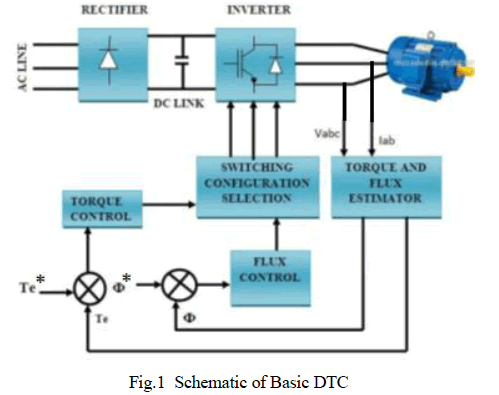 |
A. Torque and Flux Estimator |
| The feedback flux and torque are calculated from the machine terminal voltages and currents. The computation block also calculates the sector number in which the flux vector lies. The phase voltage and currents in stationary reference are given as |
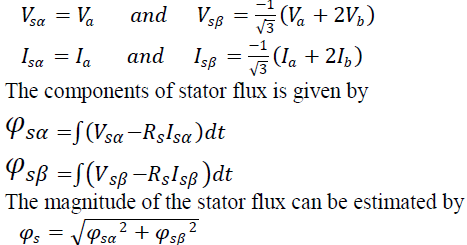 |
| The flux vector zone can be obtained using the stator flux components. By using the flux components, current components and IM number of poles, the electromagnetic torque can be calculated by |
 |
B. Torque and Flux Controller |
| The instantaneous values of flux and torque are calculated from stator variables by using flux and torque estimator. The command stator flux and torque magnitude are compared with their respective estimated values and the errors are processed by the hysteresis band controllers. The flux loop controller has two levels of digital output according to following equations. |
 |
| where is the total hysteresis bandwidth of the controller. The actual stator flux is constrained within the hysteresis band and tracks the command flux. The torque control loop has three levels of digital output represented by the following equations. |
 |
C. Switching Table |
| The switching selection block in fig.1 receives the input signals , and generate the desired control voltage vector as given in look-up table shown in Table 1. The circuit diagram of the rectifier inverter block is shown in fig. 2 where S(1), S(3) and S(5) are the upper leg switches. |
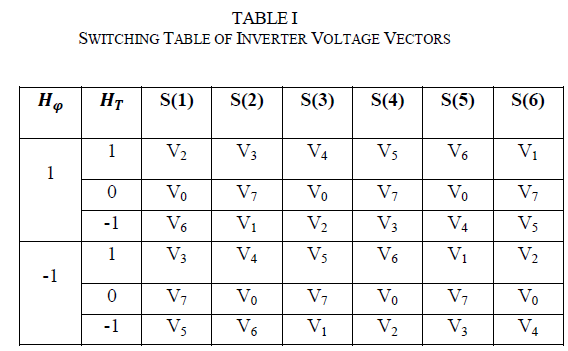 |
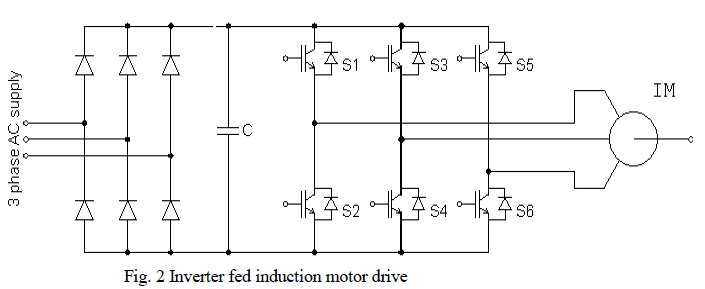 |
 |
 |
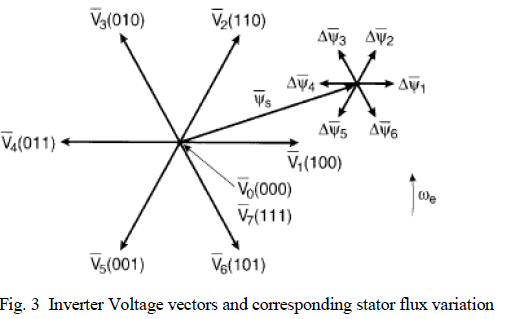 |
PRINCIPLE OF SPACE VECTOR MODULATED DTC SCHEME |
| The basic functional blocks used to implement the DTC-SVM scheme is shown in Fig. 4. In the proposed system, flux and torque estimators are used to determine the actual value of the flux linkage and torque. Instead of the switching table and hysteresis controllers, a PI controller and numeric calculation are used to determine the duration time of voltage vectors, such that the error vector in flux and torque can be fully compensated. Two proportional integral (PI) type controllers regulate the flux and torque error. Since the controllers produce the voltage command vector, appropriate space voltage vector can be generated with SVM and fixed switching frequency can be achieved. The output of the PI flux and torque controllers can be interpreted as the reference stator voltage components in d-q coordinate system. These dc voltage commands are then transformed into stationary frame (α-β), the command values are delivered to SVM block. The SVM block performs the space vector modulation of Vs to obtain the gate drive pulses for the inverter circuit. |
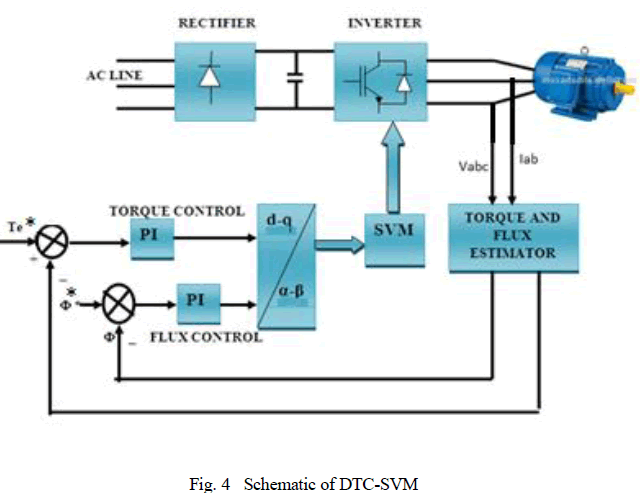 |
A. Space Vector Modulation |
| Space Vector Modulation (SVM) Technique has become the most popular and important PWM technique for three phase Voltage Source Inverters (VSI) for the control of AC motors. It has been shown to generate less harmonic distortion in the output voltages and or currents applied to the phases of an AC motor and to provide more efficient use of supply voltage. The SVM technique is used to create a reference vector by modulating the switching time of space vectors in each of the six sectors shown in Fig. 5. The space voltage vector is produced by two active vectors, and null vectors. |
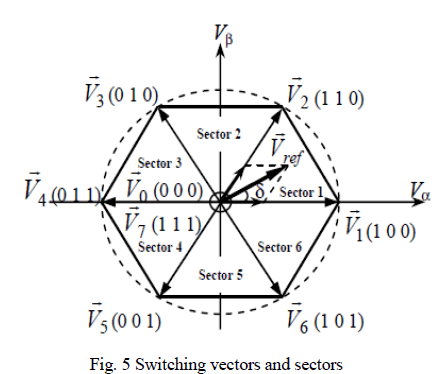 |
| Space vector PWM can be implemented by the following steps: |
| 1. Transform 3-phase to 2-phase quantity and determine Vs and angle ïÿýïÿý |
| 2. Determine time duration T1, T2 and T0 |
| 1) Determination of space vector magnitude and angle |
| In this modulation technique the three phase quantities can be transformed to their equivalent 2-phase quantity in stationary frame. The magnitude of reference vector used for modulating inverter output is, |
 |
2) Determination of time duration |
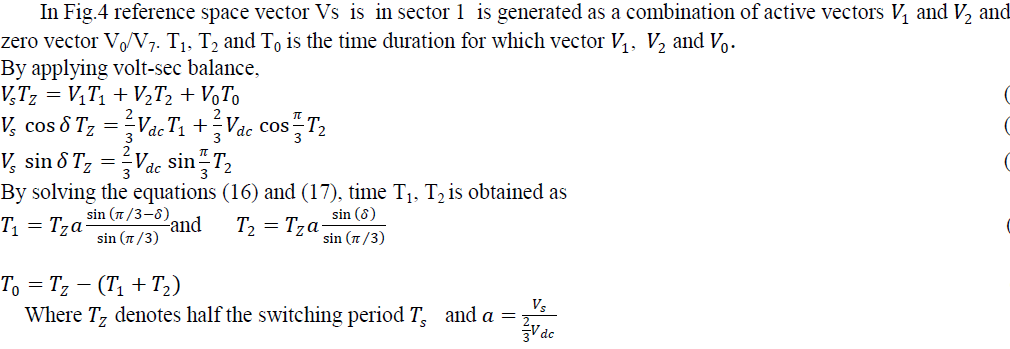 |
SIMULATION RESULTS |
| The DTC and SVM-DTC scheme for induction motor were simulated using Matlab/Simulink and their results have been compared. The motor parameters used for simulation are given. |
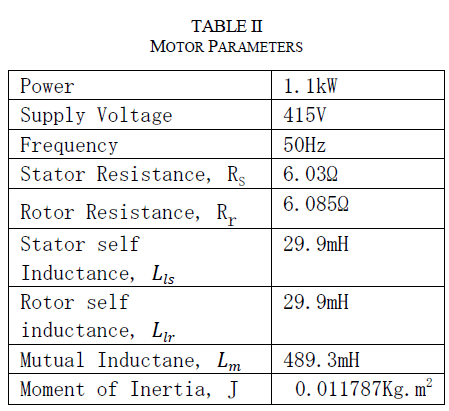 |
| Both DTC and DTC-SVM circuits was simulated and obtained sinusoidal current waveforms. Fig. 6 shows the current waveform under transient conditions where at a time period of 2seconds when the torque varies the phase current also changes suddenly without any time delay. The electromagnetic torque and flux settles to reference value i.e 3.5 Nm and 0.8wb respectively. |
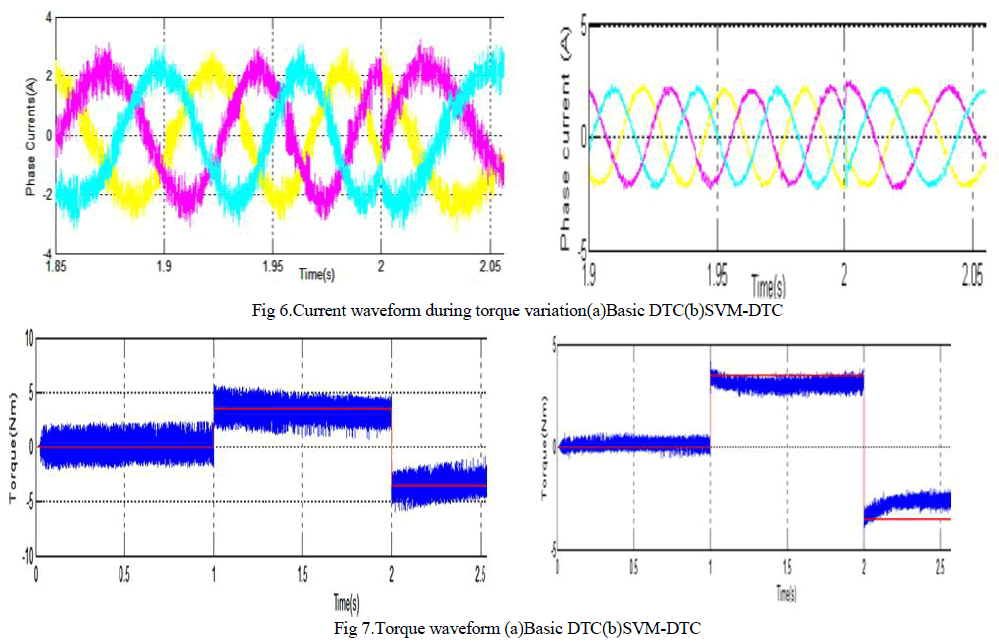 |
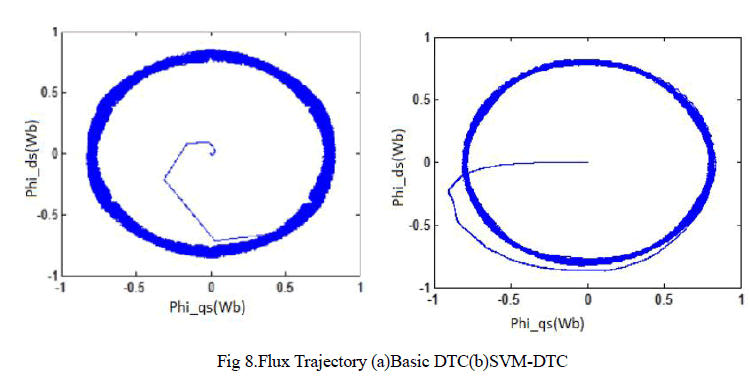 |
| The torque waveform of basic DTC scheme contains large amount of high frequency ripples and it is also reflected in the current waveform. It is clear from the simulation results of DTC-SVM scheme, the torque and current ripples have been reduced. While simulating the basic DTC induction motor drive, the ripple content obtained was about 50% and by the proposed SVM-DTC scheme, the ripple content have been successfully reduced to about 11%. |
EXPERIMENTAL RESULTS |
| To verify the simulation results, the proposed control method was implemented. The block diagram of experimental setup shown in Fig. 9, consists of a 40W,230V induction motor, MOSFET inverter switches AT89S8253 microcontroller, sensor circuits and its protection circuits. The phase voltages and currents were interfaced into the controller through analog to digital (A/D) converters. Fig. 10 shows the experimental setup. The DTC-SVM algorithm is implemented in the microcontroller. |
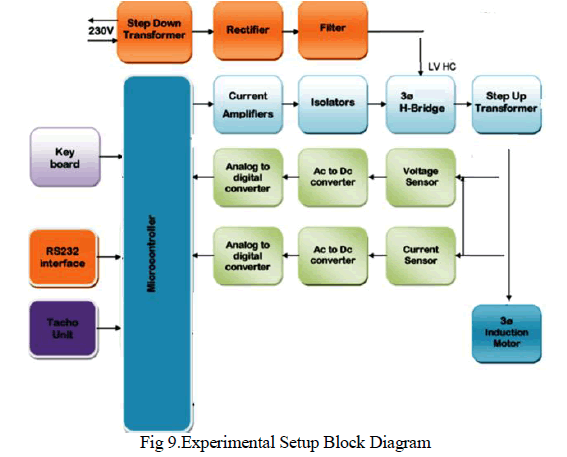 |
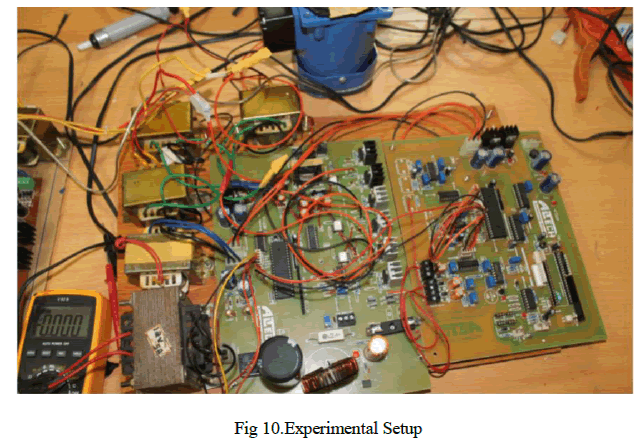 |
 |
| Fig. 11 shows the obtained waveform. The phase voltages are displaced in phase by 1200.The ripples in the current waveform is less. Fig 12 shows the torque and power readings at a particular instant of motor operation. |
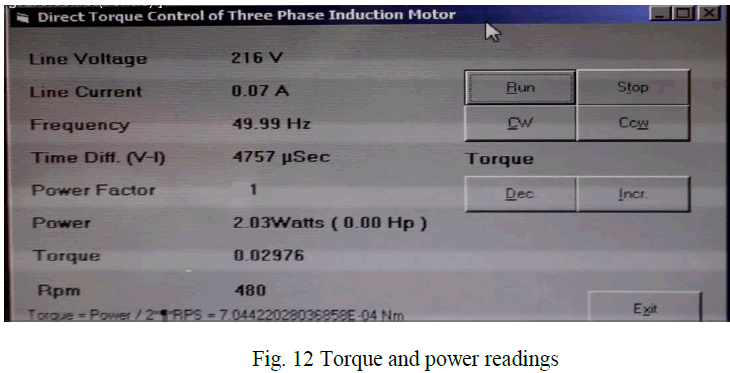 |
CONCLUSION |
| This project has reviewed Direct Torque Control strategies for SVPWM inverter-fed AC motor drives. The DTC represents a viable alternative to Field Oriented Control (FOC) being also a general philosophy for controlling the AC drives. DTC strategies have been divided into two groups: hysteresis-based switching table DTC, and constant switching frequency schemes operating with space vector modulators (SVM-DTC). Constant switching frequency SVM-DTC schemes improve considerably the drive performance in terms of reduced torque and flux pulsations, reliable start up and low speed operation, well-defined harmonic spectrum as well as radiated noise. Therefore, SVMDTC is an excellent solution for general purpose IM drives in a very wide power range. The improved performance of DTC-SVM scheme over basic DTC has been validated by simulation in Matlab software. Simulation results of the system under varying torque was achieved. Control algorithm for the DTC-SVM scheme was developed for a 40W Induction motor using AT89S8253 microcontroller. Torque control of the motor was achieved. It is observed that the torque variation from the reference value is negligible. Thus by incorporating space vector modulation, the ripples in torque and phase current contributed by the direct torque control algorithm have been effectively reduced. |
References |
|